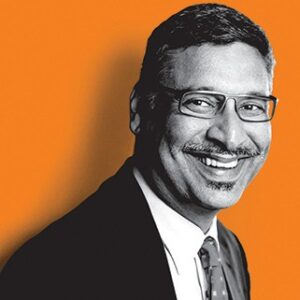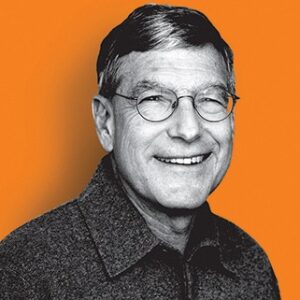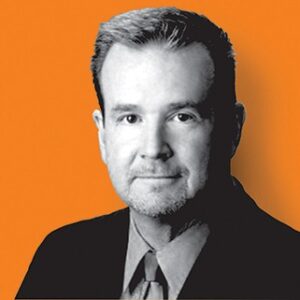Profiles in Legacy-Building
A company’s legacy is almost always linked, at least by perception, to its CEO. But CEOs do not operate in a vacuum. They have a team of leaders around them who execute their vision for the business, and in turn craft legacies of their own.
“Behind every legacy, there are many who have contributed,” says Naz Haji, senior vice president and managing director of India R&D solutions at QuintilesIMS. “You need to allow others to succeed and remember that nothing successful is ever a one-person show.”
But what does that legacy-building process look like when you are not in the CEO’s chair? We spoke with three top executives to find out what kind of future they are working to create for their organizations and what marks they are striving to leave.
Naz Haji
Senior vice president, managing director, India R&D solutions, QuintilesIMS, Mumbai, India
 QuintilesIMS is a multinational provider of integrated information and technology-enabled services for the health care industry. As the leader of the company’s India operations, Mr. Haji strategizes for and supports organizational growth in the country. The problem is that he is battling preconceived notions about its clinical research environment.
QuintilesIMS is a multinational provider of integrated information and technology-enabled services for the health care industry. As the leader of the company’s India operations, Mr. Haji strategizes for and supports organizational growth in the country. The problem is that he is battling preconceived notions about its clinical research environment.
Biopharma companies are increasingly interested in India as a destination for clinical research because of the low costs and large pool of potential patients to recruit from. But an unpredictable regulatory environment from 2013 to 2015 created inconsistencies and delays in gaining regulatory approvals, which negatively impacted global perceptions about doing clinical research in the country.
“The biggest challenge I face is one of awareness and perception,” Mr. Haji says. So two of his primary goals are ensuring internal and external stakeholders are well-versed in the positive regulatory changes that have recently occurred and changing the narrative about doing clinical research in India by highlighting the advantages the country offers.
QuintilesIMS is also in the midst of a major transition. Last year global pharmaceutical contract-research organization Quintiles merged with IMS Health, a global health care information and technology services provider, to create the new organization. Mr. Haji and many throughout the organization are still getting familiar with new teams, colleagues and protocols.
But when he looks past those challenges, Mr. Haji sees an amazing opportunity to chart a new path and build his legacy. He is responsible for defining the vision, strategic business direction and operational capabilities for QuintilesIMS India to support the company’s R&D solutions business and growth. The merger, he says, has provided a sort of blank slate, and Mr. Haji plans to push his team outside their comfort zones and to prioritize data and advanced analytics when decision-making. “I empower staff to make decisions and stand by their values,” he says. “As difficult as it is sometimes, allowing people to fail if necessary is an integral part of the leadership experience, and learning from those failures is key. Legacies are built on people being bold and decisive, and preparing the next generation to create their own legacies is just as important. The canvas is now a lot larger and so is one’s ability to make an impact.”
On a personal level, Mr. Haji wants to use his role in the health care organization to be remembered as someone who made a difference in the lives of others. “It might sound clichéd and generic, but this is something that can transcend through the internal organization all the way to customers and patients.”
Ken Goldman
CFO, Yahoo, San Francisco, California, USA
 CEOs are not the only ones whose legacies are impacted by controversy. Just ask Ken Goldman.
CEOs are not the only ones whose legacies are impacted by controversy. Just ask Ken Goldman.
Mr. Goldman has spent more than 40 years working in Silicon Valley, and prior to joining Yahoo in 2012 he served as CFO for six other firms. At each organization, his foremost objective has been uncomplicated: “I go into a company and I make investors money.”
Mr. Goldman has built a reputation for helping companies improve profits, prepare for public offerings and execute full financial transformations. At Yahoo, for instance, the stock price nearly tripled to around $45 since he took over as CFO.
It was not easy, though, as Mr. Goldman came on board when revenues were lagging and employee morale was low. It was the same year now-embattled CEO Marissa Mayer was brought in to rebuild the struggling internet brand. Mr. Goldman, for his part, spent the first three months of his tenure getting to know the corporate culture and the team.
“I have always believed that you need to listen and learn before you can start making changes,” he says. “Whether that takes 30 days or 100, it is important not to jump to conclusions before you have a sense of what’s going on.” At Yahoo he sat in on meetings and talked to the staff about their needs and where they saw opportunity for improvement to determine which changes would have the biggest impact on the company’s financial performance. He also discovered that his team needed more structure and review processes to better manage revenue growth.
His strategy was all about getting the right people, products and processes in place to drive revenue growth, he says. This included run-of-the-mill operational improvements such as the creation of a capital-authorization review committee that oversees expenditures and an approval matrix for spending. Mr. Goldman also established more formal revenue metrics and review processes to track progress and measure growth.
“We worked closely on creating better revenue metrics—by product, by region and by advertising product,” Mr. Goldman said in an interview for EY. “We created it so that we had daily metrics—we didn’t have those before. Having the daily, weekly and monthly metrics gave us the knowledge on a regular basis about how our business is working.” The metrics gave Mr. Goldman and his team a better appreciation of what they were accomplishing and where they needed to do more work.
He also oversaw the retirement of 75 products and services that were no longer producing sufficient revenue. “We had too many balls in the air,” he says. The retirements included both individual products and regions that showed low market share or revenues. “It was a collaborative effort that was closely aligned with the goals of the CEO and management team.”
All of these efforts ultimately enabled Mr. Goldman and his team to maximize cash-flow performance and drive up stock prices. “It is challenging to reinvent any technology company, but we were able to stay strong and profitable,” he says.
Recent high-profile challenges at Yahoo have not left Mr. Goldman unscathed, however. The company is still dealing with fallout from major data breaches in 2013 and 2014 that were not publicly disclosed until late 2016. Roughly 1.5 billion user accounts were compromised. As of this issue’s print date, Verizon is still in the process of closing the sale transaction with Yahoo, but the breaches have caused many to call into question actions by both Ms. Mayer and Mr. Goldman. In January, for example, The Wall Street Journal reported that the U.S. Securities and Exchange Commission is investigating whether Yahoo should have disclosed to investors information pertaining to the data breaches sooner.
As Mr. Goldman prepares for the Verizon deal to close, he remains optimistic that he will be remembered for his contribution in turning Yahoo around during this turbulent time. That is exactly the legacy a CFO should create, he says.
“I’m so appreciative of the fantastic team I inherited here at Yahoo, and I’m grateful for their support over my years here. I’d say my only regret is that we didn’t have the stellar executive team we do now when we started five years ago. That said, overall, I feel very good about what I’ve accomplished here with the support of the team.”
David Harkness
Senior vice president, business systems, and CIO, Xcel Energy, Minneapolis, Minnesota, USA
 David Harkness is determined to build a legacy that transcends obsolescence. To him, that means not only being a positive and innovative force on the business side of the equation, but also working to create a successful new generation to drive the utility company forward once he and his fellow executives are gone.
David Harkness is determined to build a legacy that transcends obsolescence. To him, that means not only being a positive and innovative force on the business side of the equation, but also working to create a successful new generation to drive the utility company forward once he and his fellow executives are gone.
He does not want to be remembered as the man who moved Xcel Energy to the mainframe or digitized the customer experience, because 10 years from now, no one will care, he says. “As a CIO, you can’t build your legacy around technology—it moves too fast.” Share on X
Instead, he seeks to be remembered as the CIO who taught his people how to collaborate and problem solve to achieve the company’s strategic goals through the innovative use of technology. He wants to create “a legacy of enablement.”
This starts with building a culture of empowerment on his teams and acting as a coach more than a director. For instance, from the moment new hires come on board, rather than prescriptively tell them what to do, Mr. Harkness expects that they will be innovative problem solvers who can find answers and set goals on their own. In turn, he supports them and their career trajectories at Xcel Energy by providing on-the-job leadership and educational opportunities, such as taking on a project in a new vertical or moving into vendor management.
“I encourage my team to look at every situation as an opportunity to build their résumé,” Mr. Harkness says. Whether it is taking the lead on a big project or helping to streamline operations to remain competitive, he wants them to constantly look for ways to develop new skills and learn new things. “That’s how we build leaders who will move Xcel Energy into the future.”
“My goal is to make Xcel Energy great—not the IT department great. We are doing that by thinking strategically, increasing efficiency and maximizing the value we provide our partners.”
Creating a tech environment that prioritizes skill development is the best way to keep good employees, he adds, which is a vital part of setting the company up for long-term success. “People in tech want to be in a place where they can continuously learn,” he says. “If you create that, they will stay.”
While Mr. Harkness feels his true legacy lies in his people, he is also proud of the dose of innovation he and his team have injected during his tenure. When he started as CIO seven years ago, Xcel Energy had a strong operational team, but they were mostly focused on keeping things running smoothly. Now, his team oversees more than 100 projects—up from just 40 when he came on board—which include new applications of analytics, machine learning capabilities, mobile tools, cybersecurity features and functionality that allows consumers to sell energy from their own solar panels back to the grid.
As part of this innovation influx, Mr. Harkness has spent a lot of time keeping the team focused on the strategic goals behind the technology. Too often, he says, IT departments can get so enamored with what they are building that they forget to think about whether it is best for the company and its most important stakeholder. “You can never lose sight of who your customer is,” Mr. Harkness says. “My goal is to make Xcel Energy great—not the IT department great. We are doing that by thinking strategically, increasing efficiency and maximizing the value we provide our partners.”



